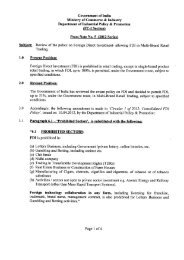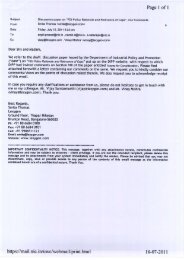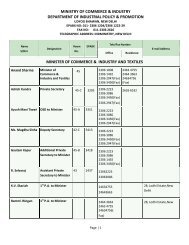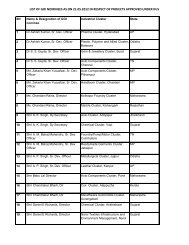fdi in india and its growth linkages - Department Of Industrial Policy ...
fdi in india and its growth linkages - Department Of Industrial Policy ...
fdi in india and its growth linkages - Department Of Industrial Policy ...
You also want an ePaper? Increase the reach of your titles
YUMPU automatically turns print PDFs into web optimized ePapers that Google loves.
three categories, namely, (i) <strong>in</strong>vestment of a non-resident direct <strong>in</strong>vestor <strong>in</strong> resident direct <strong>in</strong>vestment enterprises, (ii)<br />
reverse <strong>in</strong>vestment of non-resident direct <strong>in</strong>vestment enterprises <strong>in</strong> resident direct <strong>in</strong>vestors <strong>and</strong> (iii) <strong>in</strong>vestment of nonresident<br />
fellow enterprises <strong>in</strong> resident fellow enterprises. These categories under the asset/liability pr<strong>in</strong>ciple can be<br />
further subdivided <strong>in</strong>to sub-classes accord<strong>in</strong>g to the residence of the ultimate controll<strong>in</strong>g parent, that is, the direct<br />
<strong>in</strong>vestor at the top of the control cha<strong>in</strong>. These classes can also be grouped by <strong>in</strong>dustrial activity <strong>and</strong> the residence of the<br />
FDI partners. Further, FDI accounts are presented <strong>in</strong> three blocks, viz., FDI positions, 5 FDI transactions <strong>and</strong> FDI<br />
<strong>in</strong>come. Information on these blocks can be obta<strong>in</strong>ed from the balance sheet entries of direct <strong>in</strong>vestors, direct <strong>in</strong>vestment<br />
enterprises <strong>and</strong> fellow enterprises.<br />
However, under the directional pr<strong>in</strong>ciple the presentation of FDI statistics requires rearrangement of some of these<br />
build<strong>in</strong>g blocks. In case the direct <strong>in</strong>vestment enterprise holds less than 10 per cent of the vot<strong>in</strong>g power <strong>in</strong> <strong>its</strong> direct<br />
<strong>in</strong>vestors, any <strong>in</strong>verse <strong>in</strong>vestment (either equity or debt) from the direct <strong>in</strong>vestment enterprise to <strong>its</strong> direct <strong>in</strong>vestor is to<br />
be accounted for under outward or <strong>in</strong>ward appropriately, as opposed to the asset/liability equivalent. Further, record<strong>in</strong>g<br />
of transactions <strong>and</strong> positions between fellow enterprises under the directional pr<strong>in</strong>ciple is to be made appropriate by<br />
br<strong>in</strong>g<strong>in</strong>g modifications where necessary to their asset/ liability equivalents to provide the directional <strong>in</strong>formation. 6 The<br />
presentation of data under the directional pr<strong>in</strong>ciple is the preferred one, especially for <strong>in</strong>dustry <strong>and</strong> country classification<br />
of FDI data.<br />
8.8 Industry Classification of FDI Statistics<br />
For better economic plann<strong>in</strong>g <strong>and</strong> decision mak<strong>in</strong>g, <strong>in</strong>vestment enterprises should be grouped by type of economic or<br />
<strong>in</strong>dustrial activity. It should be made available both for <strong>in</strong>ward <strong>and</strong> outward foreign direct <strong>in</strong>vestment by both the<br />
<strong>in</strong>dustry of direct <strong>in</strong>vestment enterprise <strong>and</strong> the <strong>in</strong>dustry of direct <strong>in</strong>vestor. In case the data cannot be compiled for both<br />
types, the Benchmark Def<strong>in</strong>ition recommends that the data should be compiled at least accord<strong>in</strong>g to the activity of the<br />
direct <strong>in</strong>vestment enterprises, <strong>and</strong> this should be compiled for both <strong>in</strong>ward <strong>and</strong> outward direct <strong>in</strong>vestment. The <strong>in</strong>ward<br />
<strong>in</strong>vestment should reflect the <strong>in</strong>dustry of the resident direct <strong>in</strong>vestment enterprise <strong>and</strong> outward <strong>in</strong>vestment should show<br />
the <strong>in</strong>dustry of the non-resident direct <strong>in</strong>vestment enterprise.<br />
Even though many direct <strong>in</strong>vestors <strong>and</strong> direct <strong>in</strong>vestment enterprises are <strong>in</strong>volved <strong>in</strong> a wide range of economic activities,<br />
they must be classified <strong>in</strong>to a s<strong>in</strong>gle <strong>in</strong>dustry. In fact, the <strong>in</strong>dustry classification should be based on the pr<strong>in</strong>cipal<br />
economic activity, which can be determ<strong>in</strong>ed based on the contribution of an activity to the value-added of the enterprise.<br />
Further, the presentation of the data should be based on the report<strong>in</strong>g enterprise. That is, if the report<strong>in</strong>g entity is a<br />
direct <strong>in</strong>vestment enterprise <strong>and</strong>, at the same time, a direct <strong>in</strong>vestor, <strong>its</strong> <strong>in</strong>dustry classification should be based on<br />
activities it conducts <strong>and</strong> should exclude activities conducted by <strong>its</strong> own FDI enterprises. In the case of subsidiaries,<br />
associates <strong>and</strong> branches of an enterprise, the <strong>in</strong>dustry of the enterprise should be the pr<strong>in</strong>cipal activity of that enterprise<br />
only. For <strong>in</strong>ternational comparison <strong>and</strong> statistical consistency, the OECD Benchmark Def<strong>in</strong>ition recommends the use<br />
of the International St<strong>and</strong>ard Industry Classification (ISIC) for compil<strong>in</strong>g FDI statistics. 7<br />
8.9 Distribution of FDI by DIPP Classification<br />
This section presents the distribution of FDI compiled from company records received from DIPP, which we used to<br />
prepare unique companies for draw<strong>in</strong>g of samples. As mentioned, the distribution of FDI <strong>in</strong>cludes only FDI received<br />
by different companies <strong>in</strong> a particular year <strong>and</strong> does not <strong>in</strong>clude stock swaps, advance <strong>in</strong>flows, NRI schemes <strong>and</strong> other<br />
miscellaneous receipts. Table 8.1 shows the FDI <strong>in</strong>flows from 2000 to 2007. In terms of US dollars, FDI <strong>in</strong>flow<br />
<strong>in</strong>creased from US$2 billion <strong>in</strong> 2000 to US$11 billion <strong>in</strong> 2006. Despite the slowdown <strong>in</strong> <strong>in</strong>vestment dur<strong>in</strong>g 2003, it has<br />
5. FDI position shows the level of <strong>in</strong>vestment at a given po<strong>in</strong>t of time. It is also referred to as FDI stocks.<br />
6. For details, see OECD (2008), Chapter 4.<br />
7. For details, see OECD (2008), Chapter 7.<br />
FDI DATA REPORTING AND CLASSIFICATION<br />
95












